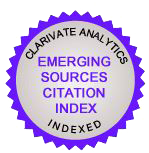Avoiding of Communication During an Unpleasant Conversation in the Russian Communicative Culture (on the Material of Internet Forums)
Keywords:
Communication, strategy, tactics, avoiding of communication, talking, taboo, euphemismAbstract
The way to avoid communication is one of the frequent subjects of scientific research. This strategy allows communicants to stop unwanted communication and an unpleasant conversation. During some decades the study of an unpleasant conversation was limited to determine only forbidden subjects (taboos) which helped to avoid conflicts and misunderstandings. However, the modern communication is characterized by a new type of communicants, who do not maintain the interlocutor’s image, but preserve good self image and own communicative space. The development of the individualist culture of present-day society brings to the fact that a person does not want and does not consider necessary his remaining in an uncomfortable state of communication.This article deals with not just only topics of conversation which are potentially unpleasant for Russian-speaking communicants, but also with basic tactics which allow avoiding communication and are widely used in the contemporary Russian communicative culture.
The material of the study consists of Internet forums texts where users discuss unpleasant topics of conversation and express different manners to avoid them in communication. The selection of this material is not random. First of all, the access to Internet communication allows to analyze a large number of texts and to obtain reliable results. On the other hand, Internet communication reflects the communicative culture of present-day native speakers. An important factor to choose the material for this research was also the peculiarity of Internet communication. Thus the anonymity allows users to answer sincerely for a moderator’s questions and to give examples from their personal lives.
Downloads
Downloads
Published
How to Cite
Issue
Section
License

CC BY-SA: This license allows reusers to distribute, remix, adapt, and build upon the material in any medium or format, so long as attribution is given to the creator. The license allows for commercial use. If you remix, adapt, or build upon the material, you must license the modified material under identical terms.
CC BY-SA includes the following elements:
BY ![]() – Credit must be given to the creator
– Credit must be given to the creator
SA ![]() – Adaptations must be shared under the same terms
– Adaptations must be shared under the same terms
Authors who publish with this journal agree to the following terms:
1. Authors retain copyright and grant the journal right of first publication with the work simultaneously licensed under a Creative Commons Attribution License that allows others to share the work with an acknowledgement of the work's authorship and initial publication in this journal.
2. Authors are able to enter into separate, additional contractual arrangements for the non-exclusive distribution of the journal's published version of the work (e.g., post it to an institutional repository or publish it in a book), with an acknowledgement of its initial publication in this journal.
3. Authors are permitted and encouraged to post their work online (e.g., in institutional repositories or on their website) prior to and during the submission process, as it can lead to productive exchanges, as well as earlier and greater citation of published work (See The Effect of Open Access).












